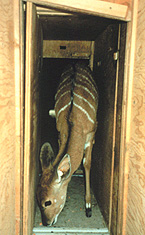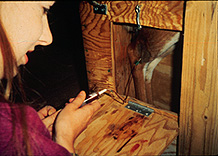

Both the nyala and bongo will enter a crate and stand still for blood sampling, injections and manual examination of the udder and other areas. Once the animals were trained, crate conditioning was maintained by one monthly session with pinching used to simulate blood testing. Blood chemistries taken from the bongo indicated very low stress levels. The mean cortisol level for three adult bongos was 4.4 ng/ml after the animals had been in the crate for over fifteen minutes. Creatine phosphokinase (CPK) and glucose levels were much lower in crate trained bongo compared to the values which were obtained when the animals were immobilized. For four animals, the CPK mean was 70.75 IU for crate conditioned and 288.75 IU for immobilization with pharmaceuticals. The means for glucose were 61.25 mg/dl in crate conditioned and 166.5 mg/dl in immobilized.
The results show very clearly that stress levels were greatly
reduced in the bongo which voluntarily cooperated during blood sampling.
The mean cortisol, CPK and glucose levels were much lower than published
values obtained from immobilized animals. International Species Inventory
System (ISIS, 1992) values for CPK were over five times higher than our
crate conditioned animals. This is very important from both a welfare and
a medical standpoint because CPK is a measure of muscle damage due to
stress as injury. Glucose levels in our crate conditioned bongos were
almost half the ISIS values. Cortisol, the common measure of stress, was
almost at the baseline (resting unstressed) levels for cattle (slam and
Dobson, 1986; Mitchell et al., 1988). Cortisol levels in netted and
manually restrained deer were almost ten times higher (Hastings et al.,
1992).


Our results show very clearly that even flighty,
excitable
animals such as the bongo and the nyala can be trained to cooperate with
veterinary procedures. At the Denver Zoological Gardens, crate training
has improved animal welfare and greatly facilitated veterinary care and
shipment of animals. Crate trained animals voluntarily enter a crate for
shipment. Crate training also makes it possible to establish accurate
baseline blood chemistries which are not confounded by stress. It also
makes it possible to give better veterinary care because injections and
examinations can be done without stressful chemicals or forced manual
restraint. Training takes time, but the effort will be well rewarded.